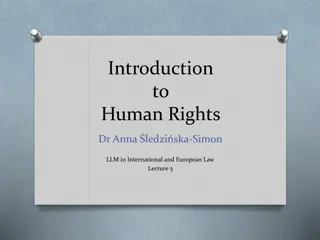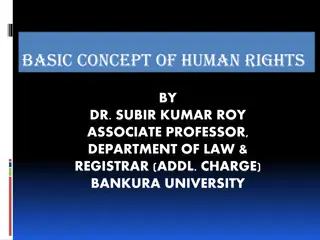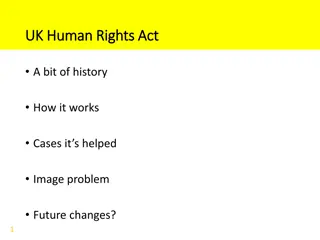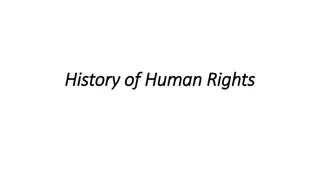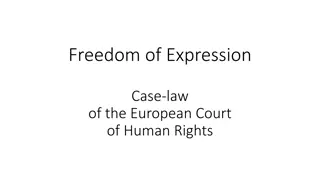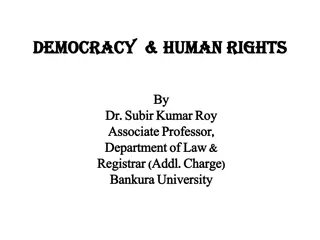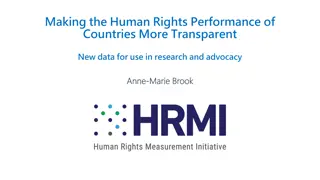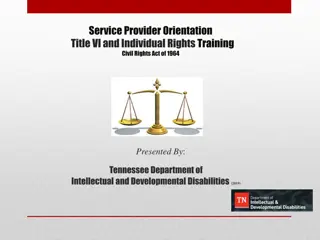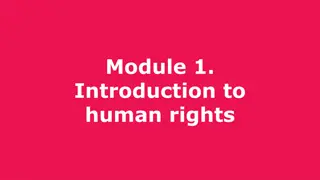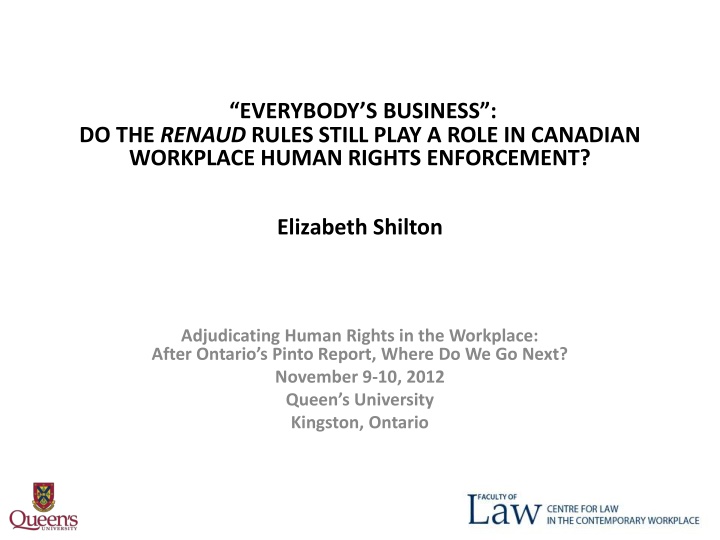
The Renaud Rules and Workplace Rights Enforcement in Canada
Discover the impact of the Renaud Rules on Canadian workplace human rights enforcement and the implications for unions and employers. Explore the two types of liability, jurisdictional disputes, and the expansion of scope of arbitration in this insightful discourse.
Download Presentation

Please find below an Image/Link to download the presentation.
The content on the website is provided AS IS for your information and personal use only. It may not be sold, licensed, or shared on other websites without obtaining consent from the author. If you encounter any issues during the download, it is possible that the publisher has removed the file from their server.
You are allowed to download the files provided on this website for personal or commercial use, subject to the condition that they are used lawfully. All files are the property of their respective owners.
The content on the website is provided AS IS for your information and personal use only. It may not be sold, licensed, or shared on other websites without obtaining consent from the author.
E N D
Presentation Transcript
EVERYBODYS BUSINESS: DO THE RENAUD RULES STILL PLAY A ROLE IN CANADIAN WORKPLACE HUMAN RIGHTS ENFORCEMENT? Elizabeth Shilton Adjudicating Human Rights in the Workplace: After Ontario s Pinto Report, Where Do We Go Next? November 9-10, 2012 Queen s University Kingston, Ontario
What are the Renaud Rules? Central Okanagan School District No. 23 v. Renaud, [1992] 2 SCR 970 Gohm v. Domtar Inc (1990), 12 C.H.R.R. D/161 (Ont. Bd. Inq.), aff d (1992) 89 DLR (4th) 305 (Ont. Div. Ct.)
Two types of liability Type 1 Liability Type 2 Liability Where the union participates in the formation of the discriminatory work rule Where the union impedes an employer s efforts to reasonably accommodate an employer in a particular case 3
Why is that a problem? a radical redistribution of the rights and obligations of companies and unions , one which imposes on unions a duty with no corresponding rights [and] subjects them to liability with no corresponding control Justice Archie Campbell, dissenting in the judicial review of Gohm
Two Factors 1. Expansion of scope of arbitration 2. Rules governing access to adjudication before HRTs in direct access jurisdictions
Expanding scope of arbitration Weber v Ontario Hydro, [1995] 2 S.C.R. 929 Parry Sound (District) Social Services Administration Board v. Ontario Public Service Employees Union, Local 324, 2003 SCC 42
Jurisdictional Disputes Quebec (Commission des droits de la personne et des droits de la jeunesse) v. Quebec (Attorney General), 2004 SCC 39 (the Morin case)
Morin Categories Arbitrators have exclusive jurisdiction Arbitrators have concurrent jurisdiction with HRTs The essential character of the dispute arises from the collective agreement DESPITE the fact that it is a human rights dispute The essential character of the dispute is discrimination (but the fact that it is filed as a discrimination claim is not determinative)
Potential Morin factors? Disputes about whether the terms of the agreement are discriminatory? (Renaud Type 1) Disputes about the negotiation (rather than the application) of the agreement ? (Renaud Type 1) Disputes where the union will not file a grievance? Where the union is opposed in interest? Disputes affecting large numbers of people? Disputes where some respondents are not parties to the agreement?
Unionized Employees in Direct Access Jurisdictions Deferral (OHRC, s.45) Summary Dismissal if the Tribunal is of the opinion that another proceeding has appropriately dealt with the substance of the application (Ont HRC, s.45.1)
No More Dual Adjudications Figliola v. Workers Compensation Board (No. 2), 2011 SCC 52 Three elements: Was there concurrent jurisdiction to decide human rights issues? Were the previously decided legal issue was essentially the same as what is being complained of to the Tribunal? Was there an opportunity for the complainants or their privies to know the case to be met and have the chance to meet it?



